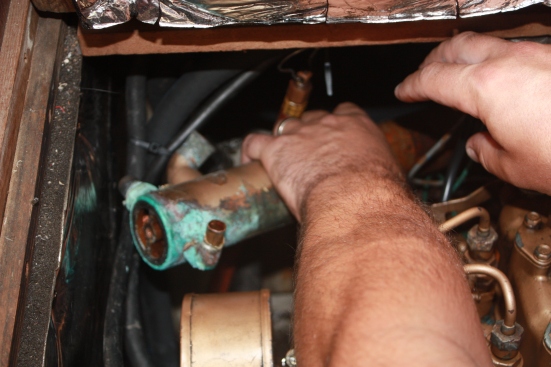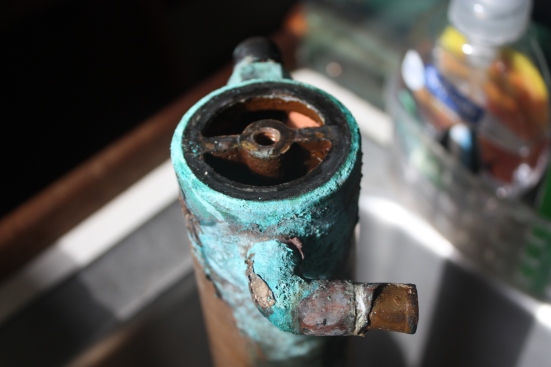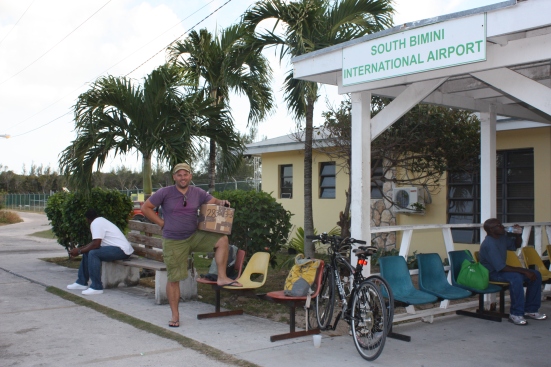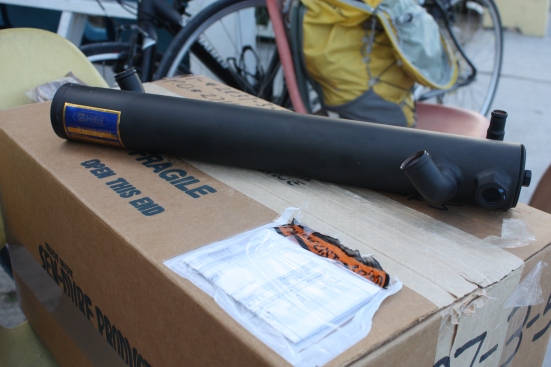If you’d told me a week ago that for $25 we could order an engine part from Fort Lauderdale at 9:30 am and it would be in our hands in the Bahamas at 4:30 pm the same day, I would have either told you to “shut the front door,” or I would’ve forgone all those last-minute trips to West Marine back in Fort Lauderdale. Or at least I wouldn’t have worried so much about getting boat parts in the islands.
Since I can’t be sure that our situation was typical, though, I won’t venture quite that far. Perhaps I should say, instead, if you’d told me a week ago that I would be able to identify almost every part of our diesel engine (and take most of it apart), after spending six years knowing only where the coolant and oil goes, I’d have definitely told you to shut the front door.
But so it was.
We suspected something was awry with our engine when we left for Bimini last week. And our hunch was that the problem had surfaced as a result of loading down the rear end of our boat too heavily. We just couldn’t figure out how, exactly, that would have resulted in the engine spitting hot sea water onto our cabin floor.
And to confuse us further, when we returned to Fort Lauderdale, after aborting our first attempt to cross the Gulf Stream, we couldn’t seem to recreate the same problem. Which had us perplexed.
Luckily, though, I posted our engine questions on that trusty boating forum we call Facebook, and our many boat-savvy friends responded with lots of possibilities.
So, as it went, the conversation between me, Ryan and the internet played out a bit like an episode of House, except with mechanics and total amateurs (i.e. us), rather than doctors. And instead of a whiteboard, we had my Facebook Wall to scribble all over.
FB Friend: It sounds like you might’ve blown a hose?
Me: Nope, it’s not a blown hose. I checked them all.
Another FB Friend: Check the cockpit scuppers and anything else that could be draining around the engine.
Ryan: But if that were the problem, the water would be cold. This water was hot. And salty. So it must have been after it went through the engine.
Me: This is just a wild theory, but is it possible that all the weight in the back could have pushed water back up through our exhaust?
Another FB Friend: We used to get seawater in through our exhaust if we ran our engine over 1800 RPMs.
Ryan (thinking): Maybe? If the water from the engine were being pushed back into the boat, that could be hot. But I think there’s a valve to prevent that from happening. Also, we regularly run the engine at 2200 and this has never happened.
Me: Could the exhaust valve have gone bad under pressure?
FB Friend: Have you checked your engine zincs?
Me: The engine has zincs?
FB Friend: Indeed it does.
Me (to Ryan): Did you know the engine has zincs?
Ryan: I know the prop has zincs.
Me: Where’s the service manual? Really? It says the zinc’s in the heat exchanger. What?! How could we not know this?!
Amazingly, with that one, tiny question, we snowballed towards a realization. And the theory that resulted, is this:
- There was no sacrificial zinc left in our heat exchanger to combat salt water corrosion (and we don’t know how long we were without one).
- The “walls” separating the coolant from raw water in the heat exchanger were probably hanging on by a thread, but were still functioning.
- When we loaded down the back of Hideaway and took her out to sea, the pressure created by the exhaust being submerged in water (and not allowing water to escape freely) caused the walls in the heat exchanger to finally break down.
- At that point, coolant began mixing with salt water and running through the engine. The overflow then released excess hot salt water from the engine out onto our floor.
- Which explains why, when I drained the heat exchanger, I got salt water and not coolant. The coolant had been mixing with salt water and diluting it when it shouldn’t have.
- The reason we couldn’t recreate this when the engine was idle or cool was because the heat exchanger is only engaged when the thermostat kicks in to say the engine needs cooling.
All of the above dictated that, though our engine ran cool all the way to Bimini, when we arrived and found salt water on the floor of the engine compartment, we knew that we hadn’t fixed the problem back in Fort Lauderdale at all. We thought if we redistributed the obscene weight of our provisioning, then we would relieve the pressure off our exhaust and all would be well. Unfortunately, though, we believe the damage was already done.
What was really mind-blowing, though, was that we managed to track down a distributor of our exact Sen-Dure Heat Exchanger, a $300 part, in Fort Lauderdale. And though the salesmen at Jerry’s Marine weren’t the friendliest, and it took a lot of coaxing to get them to pull our part out of inventory, in the end, they did what we asked them to… which was to deliver the part to a local airline in Fort Lauderdale who had already agreed to cargo ship the part to the Bimini Airport for a mere $25.
And though, on Friday, the Fort Lauderdale-based Pioneer Air Service said they could probably get the part to us on Monday afternoon (which we were more than thrilled with), they called us back to let us know the part would be at the airport that day at 4:00 pm. And could we come pick it up today? What?!
So, we dropped what we were doing, hopped on our bikes, took a ferry (and by ferry, I mean a 10-passenger boat) over to South Bimini, and cycled down the island’s one dirt road. Along the way, just to be sure, we asked a few people for directions, resulting either in someone smiling and shouting “That way, mon!” or looking at us sideways, smiling and perplexed that we should need directions to anywhere along the island’s only road.
When we got to the airport after about 5 minutes of dusty cycling, we encountered a building the size of a small apartment, sign-posted as “Bimini International Airport.” Ryan went in with his cruising permit to prove he didn’t need to pay taxes on this particular import because it was for repairs, while I stood outside guarding the bikes and watching as a low-flying plane buzzed the parking lot, causing the taxi drivers and deliverymen standing outside to erupt in laughter, cursing and waving. This was definitely not JFK.
But just like that, with a bit of Bahamian friendliness, we had a new heat exchanger in hand, and we were free to hit the local Beach Club on South Bimini for a few Gombay Smashes to celebrate before heading home.
Who knows if it was the Gombay Smashes or just us being on Island Time, finally, but we didn’t hurry to get our new heat exchanger in the next day. Instead, we went out and chatted with the fishermen hanging out at Bimini Big Game Club, watched the bull sharks have a feeding frenzy around the docks where they cleaned the day’s catch, and poked around the engine to see what we needed to do to flush out the salt water… whenever we got to that.
It was nice not to be in such a hurry anymore. Sure, we busted our engine and that was no one’s fault but our own. But we learned so much in the process. What was formerly a frighteningly cryptic hunk of metal and rubber hoses, was now completely demystified.
And, sure, we had a new heat exchanger that needed installing before we could go anywhere.
But relax, mon. We’ll get to it.





Do you realize just how LUCKY you are getting the heat exchanger as quickly as you did and for ONLY $25.00?? I fellow cruiser ordered a $15 part for his saxophone shipped down Island and paid $170.00 in import fees and duty to get the part and it was NOT fast. So glad that all is well that ends well for you.
Lorraine
S/V Changes
Lorraine,
That’s CRAZY! I suspected that our experience was not the norm, so I didn’t want to count on that for the future but was VERY pleased with the experience (and cost!). Yes we are very very very lucky 🙂
Tasha
I just must read you everyday!!!!
The mixing elbow is next, keep an eye on it if you have not changed it out already. You should join and follow sailnet forum. The members are really sharp with great expert advice. I can’t tell you how much I learned from them. They are really great in a situation like yours with a problem you are trying to figure out.
http://www.sailnet.com/forums/gear-maintenance/
So what you’re saying is… I should consult experienced sailors so I can PREVENT my inevitable problems in advance, instead of just waiting for things to BREAK, then PANICKING and desperately checking forums for SOLUTIONS RIGHT NOW. What are you, some kind of genius?!!! 🙂
LOL, well btw I am a genius, and I appreciate your astute grasp of the obvious:)
What I was suggesting was to post your engine problems on sailnet rather than facebook. There are people waiting and salivating for interesting problems to solve on that forum. And they do it very nicely. And along the way they may suggest “while you have your hands all over X you might as well check out Y for a future problem”. While there are many many sailing forums out there I have found sailnet to be the best. And I have no association with sailnet btw, just trying to be helpful.
Sometimes I just snap a quick pic from my phone of some random and mysterious item in my engine room, post it and ask “what the heck is this, and what does it do?” Moments latter an answer appears. Like magic.
Hey, loved the info on TRX, going to take a class on it in my gym soon. Great idea! Perfect for a boat.